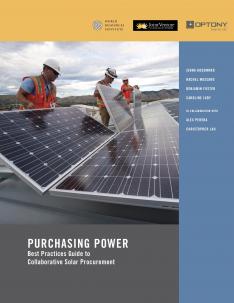Purchasing Power
Best Practices Guide to Collaborative Solar Procurement

Synopsis
This Best Practices Guide is intended to assist commercial and government entities in the process of organizing and executing a collaborative solar purchase.
Executive Summary
Background
Solar photovoltaics (PV) is a commercially proven technology and, in markets with incentives, can compete with traditional fossil fuel-based power. Wider adoption and decreases in manufacturing costs are driving down the cost of solar electricity. As the industry grows and matures, it will optimize and standardize its practices to further reduce costs and make solar energy accessible to a mainstream market. The crucial role of policy in accelerating this industry growth and maturation cannot be understated. Today, however, several barriers remain to bringing solar PV to scale:
- Transaction costs can be high. Because the industry is fragmented and installation processes are not standardized around the country, each developer has different procedures and negotiated contracts. Allocating internal staff resources to research solar power and to negotiate fair contracts for each potential site can be expensive.
- Learning takes time and effort. Potential buyers have to learn on their own about the solar market, financing, and technology, while building internal consensus for moving forward.
- Demand is fragmented with many individual sites being developed opportunistically. The current patchwork approach of designing, permitting, contracting, and installing systems for one facility at a time is inefficient.
These barriers help explain the slow pace of solar PV adoption among commercial and government consumers. However, collaborative purchasing can help overcome these barriers and scale up solar PV deployment. By organizing interested consumers (and their potential installation sites) into groups, collaborative purchasing can reduce transaction costs, educate potential buyers, and aggregate demand so that solar panels can be installed at lower-than-average costs.
Purpose
This Best Practices Guide is intended to assist commercial and government entities in the process of organizing and executing a collaborative solar purchase. A measure of success will be the number of readers who use this guide in purchasing solar power to meet their electricity needs more sustainably and at an affordable price. The guide outlines a list of best practices, which together constitute a 12-step process to capture the economic and practical benefits of a joint purchase. The starting point for participating in such an effort is simply an interest in purchasing solar electricity. The best practices are intended as a resource for project planning and decision making. They provide specific actions in chronological order, with milestones to indicate when to move from one step to the next. The end goal is that regional groups of participants will have solar PV installed on their facilities at competitive prices.
Experts in the solar energy field, including those specializing in regional collaboration, helped to develop the best practices presented here. They are based on extensive research and real-world experiences, and are supported by case studies (one a private sector collaborative and one with public-sector participants). These two cases were unique models of regional collaboration, among the first in the country at this scale. Like all new approaches to a problem, both efforts encountered challenges along the way. Throughout the guide, we illustrate the lessons learned from these challenges, point out pitfalls to avoid, and highlight ways to streamline the process. We also provide resources, such as solicitation and procurement documents, participant questionnaires, and evaluation criteria.
By promoting the use of this guide and sample documents, we hope to encourage the use of these models for regional collaborative efforts. Successful collaboration can lead to lower costs, increased competition and vendor performance, and better projects with higher visibility.
Twelve Steps for Collaborative Solar Purchasing
- Early regional recruiting
RESULTS: Initial participants indicate interest and agree to proceed with site identification and assessment in next stage.
- Initial participant questionnaire
RESULTS: List of potential participating organizations with site opportunities and considerations documented.
- Solar project workshop
RESULTS: All participants share common understanding about the basics of collaborative purchasing, key metrics to evaluate, timeline, and expectations of them. Lead organization has been identified.
- Consolidated analysis of sites
RESULTS: Compelling technical overview of total purchase size and individual bundles. This initiative overview is consolidated into packet including talking points explaining expected benefits for participants and lead organization.
- Internal decision maker consultation
RESULTS: Buy-in to proceed in procurement process to drafting RFP is obtained from decision makers in each participant/lead organization.
- Design of procurement process & documents
RESULTS: All participants agree to procurement process, template contracts, and standard terms with understanding of risks and opportunities.
- Request for proposals
RESULTS: RFP issued with compelling bids received from potential vendors.
- Proposal evaluation
RESULTS: Winning bidder is selected for each bundle through competitive process that ensures best-value vendor selection.
- Negotiations and award
RESULTS: Negotiations are complete with successful award and signed contracts with a qualified vendor for each bundle, within agreed timeline.
- Installation project management
RESULTS: Solar PV systems are properly built to meet or exceed specifications and safety standards.
- Commissioning and operations
RESULTS: Successful solar installations demonstrate energy production and savings as planned for 25 years or more.
- Celebration of success
RESULTS: Participants' internal and external stakeholders, regional community, and government are aware of the positive impact of this effort and support future projects.